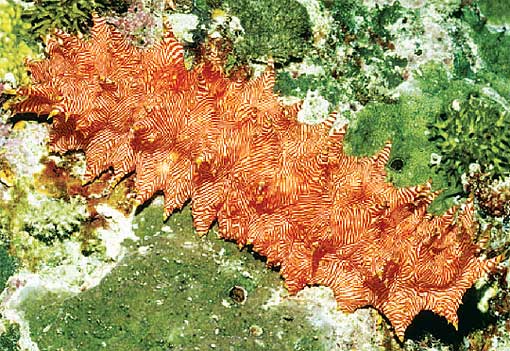Sea Cucumbers

Sea cucumbers are fleshy echinoderms without a hard skeleton or spine. The body wall contains toxins that discourage predators, some also throw out their viscera or discharge special slime when bothered. Nevertheless, when dried, the body wall and muscles of many sea cucumber species are the prized ingredients in soup and other dishes.
The mouth of the sea cucumber has feeding tentacles, which are enlarged tube feet. The feet pass sand and mud into the mouth and the animal digests what it can from the sand and mud passing through the gut. They are like magic specialized intestines sucking up and processing any refuse the ocean has to offer. In some regions, in very deep waters, they are very common and may even dominate life along the ocean floor.
Dried and jarred they do look a bit like cucumbers, but on the sea floor many have colorful designs like the candy cane sea cucumber above. They can have very vibrant colors, be colorless, or all black. For example, one species called the sea apple is usually purple with red and white; and another called the sea pig is clear.
Many countries in Asia – China, Japan, Malaysia, The Philippines, etc., enjoy eating selected species of the sea cucumber and consider it healthy dish. The taste is not supposed to be anything special but it is said to have some curative properties. Sea cucumber or “trepang” is a significant market in Asia and it can be valuable. It is farmed in artificial ponds as well as harvested from the sea. Trepang has to be dried and processed to preserve it and later re-hydrated to cook and eat or it can be cooked dry. Since demand is high and the sea cucumber is a long-living, slow-growing and slow-moving creature that lives in shallow waters where it can be hunted easily, overfishing and population decline is a possibility.
